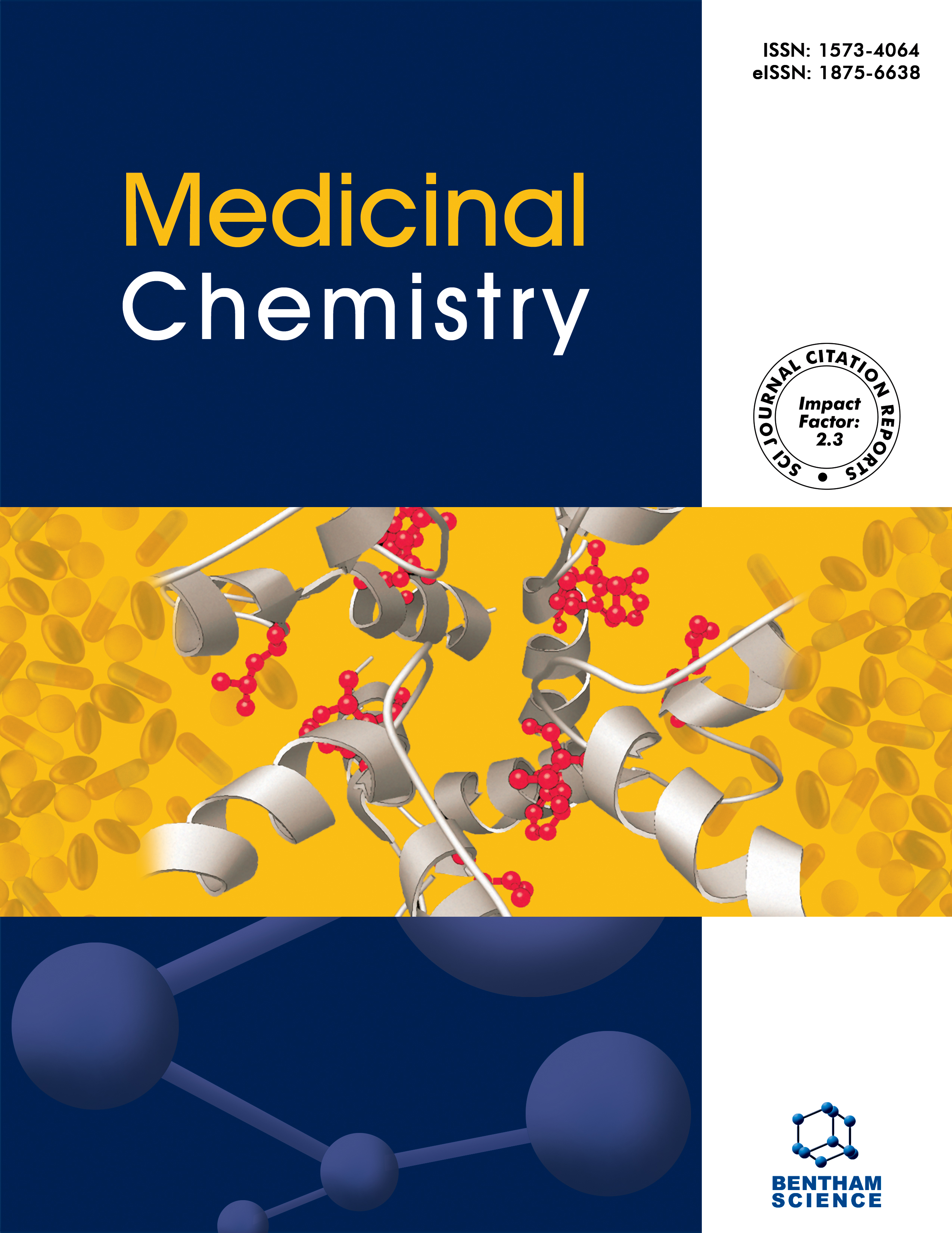- Home
- A-Z Publications
- Medicinal Chemistry
- Previous Issues
- Volume 19, Issue 9, 2023
Medicinal Chemistry - Volume 19, Issue 9, 2023
Volume 19, Issue 9, 2023
-
-
Insight on Structural Modification, Cytotoxic or Anti-Proliferative Activity, Structure-Activity Relationship of Berberine Derivatives
More LessAuthors: Mengxuan Yin, Jiajia Mou, Lili Sun, Yanru Deng and Xiaoliang RenBerberine (BBR) is a quaternary ammonium alkaloid isolated from the Traditional Chinese Medicine Coptis chinensis. It possesses a plethora of pharmacological activities because its unique structure properties make it readily interact with macromolecules through π-π stacking and electrostatic interaction. Its anti-tumor effects are receiving more and more attention in recent years. Cytotoxicity and anti-proliferation Read More
-
-
-
GPR18 and GPR55-related Ligands Serving as Antagonists or Agonists: Current Situation, Challenges and Perspectives
More LessAuthors: Linjie Zhang, Yiwen Fang, Sijing Hang, Wenhui Wu, Ruilong Sheng and Ruihua GuoGPCR superfamily, the largest known family of membrane receptors, consists of six classes from A to F. GPR18 and GPR55, δ-branch of A class, had been reported to have no confirmed endogenous ligand and were named as “orphan receptors”. Previous studies suggest that both GPR18 and GPR55 are possibly related to the migration and proliferation of cancer cells, macrophages and other inflammation-associated immune Read More
-
-
-
Quinoline-based Anti-oncogenic Molecules: Synthesis and Biological Evaluation
More LessAuthors: Shivangi Sharma, Shivendra Singh and Dhananjay YadavQuinoline and its analogues are found in various natural products, many of which are active pharmacophores with significant bioactivities. This article discussed the plethora of quinoline derivatives and their analogues that have anti-cancer properties. The review will be helpful for the scientific community since several possible anticancer drugs based on quinolines are discussed here. In addition to this, the synthetic as Read More
-
-
-
Mechanistic Role of Tempol: Synthesis, Catalysed Reactions and Therapeutic Potential
More LessAuthors: Abhishek Tiwari, Varsha Tiwari, Bimal K. Banik and Biswa Mohan SahooTempol (TP) was introduced in 1960 by Lebedev and Kazarnovskii and is an excellent catalyst extensively used in the synthesis and oxidation of various reagents. 4-Hydroxy-2,2,6,6- tetramethylpiperidin-1-oxyl (TP) has also been explored against various disorders like inflammation, superoxide anion-influenced molecular linked behavioural modifications, radical capturing, cardioprotective, protective ocular damage, Read More
-
-
-
Naphthofuran Derivative BF4, a New Potent SIRT1 Activator, Regulates Lipid Metabolism in 3T3-L1 Adipocytes via the SIRT1-AMPK Pathway
More LessAim: Our previously reported naphthofuran derivative BF4, identified as a potent silent information regulator 1 (SIRT1) activator, could alleviate high glucose stimulating apoptosis and inflammation response in human renal tubular epithelial (HK-2) cells. Introduction: In this study, the underlying effects of BF4 on lipid metabolism in 3T3-L1 adipocytes were investigated. Methods: The effects of BF4 on pre-adipocyte diffe Read More
-
-
-
Incorporating Antimicrobial Activity During Synthesis of New Acid-Azo Dyes: Thermal Stability and Application on Various Fabrics
More LessAuthors: Ambreen Sarwar, Abdul Jabbar, Saadia Riaz, Samina Parveen, Shafia Sagheer and Muhammad I. ChoudharyBackground: Textile materials are susceptible to microbial attack as they provide suitable conditions for their growth. The microbes grow with normal body secretions on garments. These microbes are responsible for the weakening, brittleness, and discoloration of the substrate. Furthermore, they cause many health issues to the wearer, including dermal infection, bad odour etc. They threaten the human health Read More
-
-
-
Effects of Alkoxy Chain Length and 1-Hydroxy Group on Anticolorectal Cancer Activity of 2-Bromoalkoxyanthraquinones
More LessBackground: KRAS and p53 are two of the most common genetic alterations associated with colorectal cancer. New drug development targeting these mutated genes in colorectal cancer may serve as a potential treatment avenue to the current regimen. Objective: The objective of the present study was to investigate the effects of alkoxy chain length and 1-hydroxy group on anticolorectal cancer activity of a series of 2- Read More
-
-
-
Tit Structure-activity Relationship Study and Design of Novel 1, 8-Naphthimide Derivatives as Potential DNA-targeting Chemotherapeutic Agents for Osteosarcoma
More LessAuthors: Zheng Lian, Hongzong Si, Huanling Xia and Honglin ZhaiBackground: 1, 8-naphthimide is a novel tumor inhibitor targeting nuclear DNA, which makes it applicable to the design and development of anti-osteosarcoma drugs. Objective: The aim of this study is to establish a satisfactory model based on 1, 8-naphthimide derivatives that makes reliable prediction as DNA-targeted chemotherapy agents for osteosarcoma. Methods: All compounds are constructed using ChemDraw softwar Read More
-
-
-
Synthesis, Characterization, and in vitro Anti-Inflammatory Activity of Novel Ferrocenyl(Piperazine-1-Yl)Methanone-based Derivatives
More LessAuthors: Banfeng Ruan, Jin Li, Qinglei Guo, Min Zhang, Zhouyang Pei and Yong HuBackground: Inflammation is closely related to the occurrence and development of various diseases in the clinical scope. Finding effective anti-inflammatory agents is of great significance for clinical treatment. A series of novel ferrocenyl(piperazine-1-yl)methanone-based sulfamides and carboxamides were synthesized to discover potent anti-inflammatory agents. Methods: The compounds were characterized by 1H NMR, Read More
-
-
-
An In silico Investigation to Identify Promising Inhibitors for SARS-CoV-2 Mpro Target
More LessBackground: A limited number of small molecules against SARS-CoV-2 has been discovered since the epidemic commenced in November 2019. The conventional medicinal chemistry approach demands more than a decade of the year of laborious research and development and a substantial financial commitment, which is not achievable in the face of the current epidemic. Objective: This study aims to discover and recognize Read More
-
Volumes & issues
-
Volume 21 (2025)
-
Volume 20 (2024)
-
Volume 19 (2023)
-
Volume 18 (2022)
-
Volume 17 (2021)
-
Volume 16 (2020)
-
Volume 15 (2019)
-
Volume 14 (2018)
-
Volume 13 (2017)
-
Volume 12 (2016)
-
Volume 11 (2015)
-
Volume 10 (2014)
-
Volume 9 (2013)
-
Volume 8 (2012)
-
Volume 7 (2011)
-
Volume 6 (2010)
-
Volume 5 (2009)
-
Volume 4 (2008)
-
Volume 3 (2007)
-
Volume 2 (2006)
-
Volume 1 (2005)
Most Read This Month
Article
content/journals/mc
Journal
10
5
false
en


